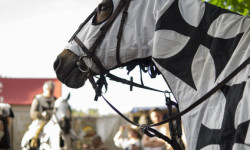In the 12th century, the Church of Europe was not only faced with enemies from the outside, more and more people questioned the doctrines of the church or adopted other faiths. In order to stop and eradicate this disintegration of the European order, Pope Innocent III. in 1209 for a crusade against the Cathars living in the south of France. These people fundamentally rejected Christianity and believed in a dualistic universe of balance.
The army of the Crusade was at the beginning of about 10,000 men. From a military point of view, this campaign was very one-sided, for the 10,000 trained knights, archers, and foot soldiers were little more than peasants. Added to this was the brutal action of the army against the so-called "heretics", alone in Béziers, the soldiers are said to have killed some 20,000 men, women and children. Although the Pope tried to stop this slaughter, but could not prevent the death of up to 1 million Cathars.
The Crusade of the German Order in Eastern Europe:
Due to the failed campaigns against the Baltic countries of Prussia and Lithuania, the people living there could neither be pacified nor incorporated into the state of the Order. So it came that the German Order received the call in defense of the faith and from 1230 invaded by Prussia in today's Lithuania, Latvia and Estonia. However, they were never really satisfied with the country, so that rebellions broke out again and again until the order's knights were encircled and destroyed by pagan warriors in 1260 during the Battle of Durbe. Since then, the Order has concentrated increasingly on its territory in Prussia, where they were able to maintain their position until the 14th century. In 1410, however, the Order faced an alliance between Poland and Lithuania, which at the Battle of Tannenberg led to a crushing defeat of the Order and finally abolished its position in Eastern Europe.
The war against the Hussites:
Another scene of intra-European crusades in the 14th century is the war against the Hussites in Bohemia. The Hussites were followers of the teachings of the Czech theologian and reformer Jan Hus, as well as their naming. However, Hus was called a heretic by the church and burned at the stake on 6 July 1415. So it happened that his followers rebelled against the Bohemian crown and in return Pope Martin V 1420 proclaimed a crusade. Due to the use of the new technique of a 20cm long handgun by the Hussites, this crusade, as well as two more in 1421 and 1424, remained stuck in a stalemate.
This post is also available in:
 Deutsch (German)
Deutsch (German)  Français (French)
Français (French)  Italiano (Italian)
Italiano (Italian)  简体中文 (Chinese (Simplified))
简体中文 (Chinese (Simplified))  Русский (Russian)
Русский (Russian)  Español (Spanish)
Español (Spanish)  العربية (Arabic)
العربية (Arabic)














